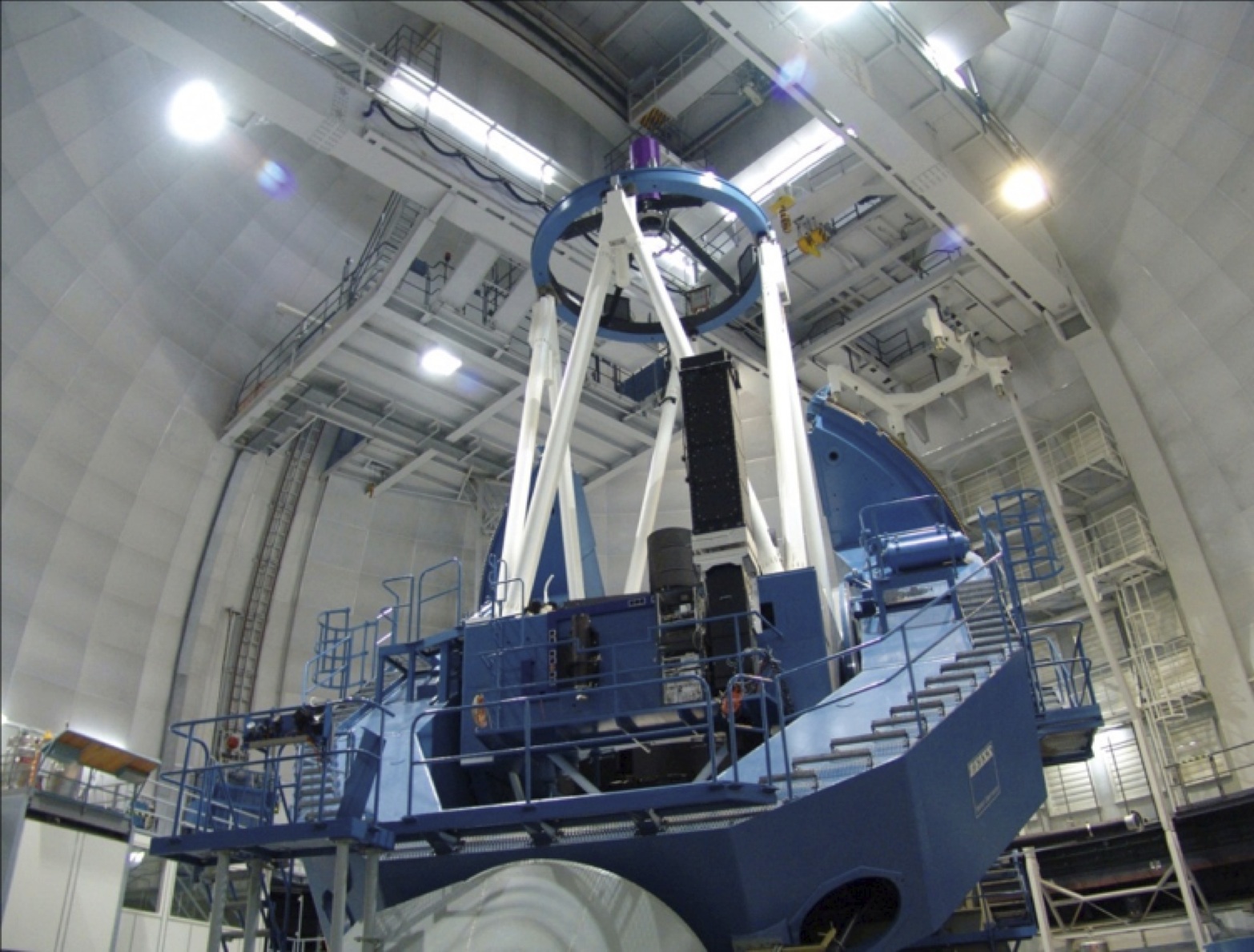The CARMENES planet hunter, with participation of ICE (IEEC-CSIC), ready to find new Earths

– The ICE (IEEC-CSIC) has also designed the ‘brain’ of CARMENES and the software that selects the optimum star to observe at each point in time
Over two thousand planets outside of our Solar System have been detected so far, and almost all of them are hostile to life due to their size or the extreme closeness to their star. The CARMENES project, carried out by a consortium of eleven German and Spanish partner institutions, including the Institute of Space Sciences (IEEC-CSIC), has been designed to look for Earth-like planets in the habitability area, which is the region around a star where conditions allow the presence of liquid water. After five years of development, the instrument has passed the test phase and is now ready to search for new Earths from the 3.5m telescope of the Calar Alto Observatory (MPG/CSIC), in Almeria, Spain.
The 3.5m telescope on Calar Alto in Southern Spain. CARMENES is installed at this telescope, and will start searching for Earth-like planets orbiting nearby stars in early 2016.
Credit: Max-Planck-Institut für Astronomie
The search for habitable exoplanets
When planets orbit around their star they produce slight oscillatory motions in it. When measured with the proper precision, these displacements act as signposts for the presence of orbiting planets. However, the search for Earth-like planets around Sun-like stars is very challenging because the oscillations are so tiny that they cannot be detected with current technology. “Therefore we will look for planets orbiting so-called M dwarfs. These are very small stars, which offer conditions for the existence of liquid water in close orbits, where we can detect the oscillation produced by planets similar to ours”, explains Andreas Quirrenbach, researcher at the Landessternwarte (Univ. Heidelberg) and the leader of the CARMENES team.
“M dwarfs are much cooler and redder than the Sun, so we have to observe both the visible and the infrared light. This is the strength of CARMENES: no other instrument can do this”, adds Dr. Pedro Amado, researcher at the Instituto de Astrofísica de Andalucía (IAA-CSIC) and the Spanish project leader of the project. This will allow avoiding false positives in planet detection, a common problem till now as the signals from the stellar activity and other stellar physical mechanisms might be confused with the existence of planets. CARMENES will be able to confirm the findings without further verification.
The scientific exploitation, in the hands of the Institute of Space Sciences (IEEC-CSIC)
The Institute of Space Sciences (IEEC-CSIC) plays an essential role in CARMENES: it is responsible for the scientific preparation and exploitation through the role of Ignasi Ribas as Project Scientist. “We lead the selection of the stars to be observed, the collection of all the information needed to guarantee the precision and analysis of the key data to discover habitable planets”, explains Ribas.
Part of the ICE (IEEC-CSIC) team at Calar Alto: Lluís Gesa, Josep Guàrdia, Ignasi Ribas and Álvaro García-Piquer.
Credit: ICE (IEEC-CSIC) CARMENES Team.
Beyond this científic role, the ICE (IEEC-CSIC) is also responsible for very important technological tasks in the CARMENES instrument. “We have built the Instrument Control System (ICS), the ‘brain’ of CARMENES. The ICS centralizes all the subsystems in CARMENES in order to control their working conditions, performance and proper environment, ensuring a robust operation”, explains Josep Colomé, manager and technical responsible of the project at the ICE (IEEC-CSIC). The institute has also built the observation scheduler, a complex piece of software that takes into account a great number of variables (object properties, prioritization, environment information) to choose the optimum star to be observed at each time.
CARMENES, in Calar Alto
Given the features and the scientific significance of the project, the Calar Alto Observatory, which is operated jointly by the Max-Plank-Society (MPG) and the Spanish National Research Council (CSIC), has allocated at least 600 nights of observing time with its largest telescope to the CARMENES consortium, a very unusual dedication in big astronomical infraestructures. “With CARMENES in operation, Calar Alto will become a global reference for Earth-like-planet searches and will be placed in the front line of astronomical instrumentation”, says Jesús Aceituno, the observatory’s deputy director.
CARMENES is a unique instrument in the world, both in precision and stability, essential qualities to measure the tiny speed variations that a planet produces in stars: CARMENES will observe stars hundreds of billions km away and will able to measure variations in their velocity of only 4 km/h, comparable to the speed of a walking person.
To achieve such accuracy, it needs not only a meticulous optical design but also maintaining the most stable conditions in the operation environment of the instrument. It will operate in vacuum condition and with temperature controlled down to the thousandth of a degree. Thanks to these features, researchers expect to discover dozens of potentially habitable planets over the next few years.
International project
CARMENES will operate in the 3.5m telescope of the Calar Alto Observatory (Almeria) and has been developed by a consortium of eleven German and Spanish institutions. In Spain, besides the Institute of Space Sciences (IEEC-CSIC), other participating institutes are: the Instituto de Astrofísica de Andalucía (IAA-CSIC), which co-leads the project and has developed the infrared spectrograph, the Universidad Complutense de Madrid (UCM), the Instituto de Astrofísica de Canarias (IAC) and the Centro de Astrobiología (CAB, CSIC-INTA).
CARMENES is funded by the Max Planck Society (MPG), the Spanish National Research Council (CSIC) and the members of the CARMENES consortium, with additional contributions by the Spanish Ministry of Economy and Competitiveness (MINECO), the state of Baden-Württemberg, the German Science Foundation (DFG), the Klaus Tschira Foundation (KTS), the Junta de Andalucía and the European Union through FEDER/ERF funds.
